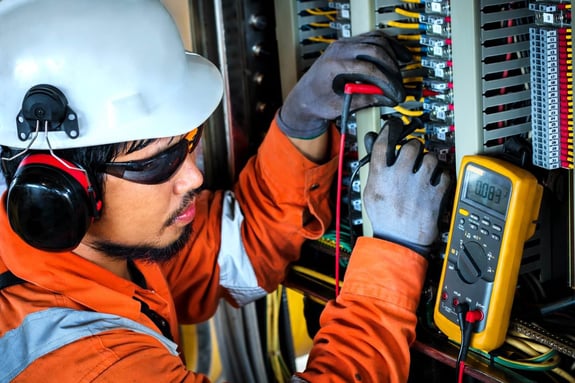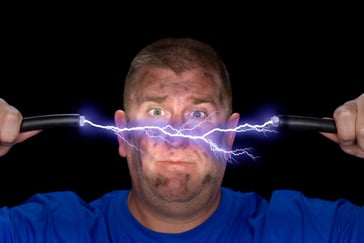Protect your eyes from the risk of arc flash
You already knew that arc flash releases hot gas and radiant energy up to 4 times the temperature of the sun, right? Let’s ponder that for a minute. When arc flash happens, the ambient temperatures can reach 35,000° Fahrenheit. And the arc blast, or pressure wave, is just as intense. Think about that the next time you burn your mouth on a slice of hot, bubbly pizza and see your life flash before your eyes. Poor thing. You know something? Arc flash is much, much worse.
Knowing the dangers of arc flash is the only way you can be sure you aren’t putting yourself into the line of fire. See, it’s not enough to kinda know about this stuff. Being aware of how to avoid injury or death is the difference between making happy hour on Friday and lying in an emergency room.
Keep reading for some things you may have not known about how to best protect your eyes against the risk of arc flash!
Did you know an arc flash can happen in many different ways?
- Spikes in voltage
- Touching test probe to wrong surface
- Worn connections
- Gaps in insulation
- Improperly installed parts
- Dust or corrosion
- Unsafe work procedures
- Mishandling tools and wires
- Negligent preventative maintenance
- Not checking for loose termination
- Not testing stored energy
- Improper electrical equipment or system design
- Improper modification
“Just in case you couldn’t connect the dots, many of the causes of arc flash accidents are due to human error.”
If you work in settings that could create any of these instances, you need to make the most informed decisions on which eye protection you choose.
Let’s say that Don works with electrical systems that have the potential for producing arc flash. He’s been through the training, he’s read NFPA 70E, he knows the risk factors, yet he ends up being one of the 30,000 arc flash incidents every year. And, he was one of the lucky ones who had a mild case of arc eye that cleared up in a few days.
It’s just this simple, Don got hurt because he got comfortable. He never saw arc flash happen before, so he took shortcuts every now and then. Sometimes, he would wear his glasses; sometimes he left them hanging on the rearview mirror in the truck. He usually did this when he was crunched for time. It’s not all his fault—his safety manager never created and enforced a standard operating procedure requiring his crew to wear safety equipment.
Choosing the right eye protection is important
When you evaluate the risks of working with electricity, safety eyewear may be one of the first things that come to mind. If you’re lucky enough to survive an explosion from arc flash, there’s likely going to be flying debris and shrapnel that could easily puncture your eye. The high-intensity flash can also damage your eyes.
The same goes for welding risks. Eye injuries are the most common injury for welders, accounting for about one-quarter of welding injuries! Arc eye is a very common and painful injury that occurs due to damage from ultraviolet radiation. Most of the time arc eye isn’t permanent, but there have been workers left with irreversible and permanent visual impairment.
Even if you don’t sustain immediate damage to your eyes, what about the long-term risks? Think about it. If you expose your eyes on a daily basis to potential harm, those effects are going to add up. It’s like Russian roulette with your eyeballs. Maybe today you walked away without incident. But—what about tomorrow or five years from now? Take our advice; you’ll better odds at a casino than taking chances with your eyes.
You also need eye protection if you want to be able to watch the next episode of Game of Thrones (don’t lie, you know you watch it).
Here’s a breakdown of the types of eye protection you can choose from:
Glasses: Safety glasses should have frames made from metal or plastic and lenses must be impact-resistant. They’ll protect your eyes from things that could bruise, pierce or damage your eyes. Keep in mind there are gaps around the glasses that debris can enter, but sealed or foam-backed eyewear is available.
Goggles: Wear these when you need tight-fitting protection that will completely cover your eyes, eye sockets and the area surrounding the eye. Typically, goggles are necessary when working with dust, splashes, vapors, splashes or need when you need protection from impact.
Faceshields: These usually extend from eyebrows to below the chin and across the worker’s entire face and may be polarized for glare protection. These protect against nuisance dust and chemical splash. Faceshields must be used in conjunction with safety glasses or goggles, never on their own.
Side shields: These offer added protection on safety glasses when there is a hazard from flying objects that could go under or around the eyewear.
Eye protection should be impact resistant, UV resistant and provide coverage over the entire eye. Workers should wear eyewear like goggles or safety glasses that offer protection from dust, impact, UV and infrared radiation and irritation from fumes. The best type of protection in these cases would be foam-backed eye protection, because they provide coverage and protection to the entire eye area.
Remember to wear safety eyewear even if you wear a face shield or helmet, unless you think you’d look good with an eye patch.
Importance of sealed eye protection
We aren’t talking about safety glasses that have a little bit of comfort foam across the brow area. We mean foam that completely seals off the delicate eye area from potential hazards. Sure, comfort is important. Workers are more likely to wear comfortable glasses, rather than tossing them in a toolbox (like the econo glasses you keep on hand). Sealed eyewear conforms to the user’s face and provides better protection from those hazards.
What good is a pair of safety glasses, if these hazards could go over, under or around the glasses? There is a reason why this type of eyewear exists. It works.
If Don had been aware of the potential dangers and used the right protective eyewear, maybe he wouldn’t have injured his eyes.
Prevent an accident before it happens!
Look, eye protection is just a tiny part of protecting workers from arc flash or blast. The reality is that the risk of serious injury or death is so high that preventative measures should always be number one. Before you rely on PPE alone, identify and train workers who will work with these hazards, perform risk assessments often, evaluate equipment, use proper lockout tagout measures and safeguard against arc flash from happening in the first place.
If you need more assistance, just look for our HELP!
What are your thoughts on foam-backed safety glasses? Have they protected your eyes? Tell us your thoughts in the comments below!
Safety: It’s Your Life, It’s Our Business










